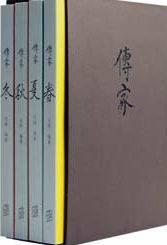Back to 1942
2013-04-29

Back to 1942
by Liu Zhenyun
Published by the Changjiang Literature and Art Press,
December 2012
Back to 1942, Chinese author Liu Zhenyuns first investigative novel, is generally accepted as an instant classic of contemporary Chinese literature. Shortly after it was first published in 1993, well-known Chinese director Feng Xiaogang was already considering adapting it for the big screen. At the end of 2012, 19 years later, Fengs film was finally released. The story of a famine that plagued hundreds of millions of Chinese people shocked audiences. A new edition of the novel soon hit bookstore shelves.
The year 1942 saw a plethora of major historical events, including the Cairo Convention, Soong May-lings visit to the U.S., the start of the Pacific naval battles, Chinese Expeditionary Forces entering Burma, Hitlers attack on Leningrad and the Yanan Rectification Movement. Along with all these historic events, a famine broke the same year in central Chinas Henan Province, leaving more than 3 million people dead and another 12 million refugees. To review the almost forgotten disaster, Liu visited survivors of the catastrophe while writing the novel. Back to 1942 has become the only book to document the disaster from decades ago.
However, it is not a novel with strong literary characters.“A novel depends largely on the authors imagination,” Liu explains. “It attempts to find truth through fiction. But, when I was writing Back to 1942, I adopted an investigative style to reflect real feelings about real events, real people and real details. To achieve this, an author must work meticulously because there is no short cut.”For director Feng, Back to 1942 tells a true story in a cold and calm tone.
Man and Earth
by Juan I-Jong
Published by the Chinese
Overseas Publishing House, January 2012
Man and Earth, a collection of photos taken by Juan I-Jong from 1974 to 1986, is perhaps the best known series from the man known as the“godfather of Chinese photography.” Many of his photos have been displayed in museums both at home and abroad and some remain as part of permanent collections. Photos documenting natural scenery and folk customs on Taiwan Island in black-white not only showcase the photographers rediscovery of the beauty of his native land, but also hint at his deep affection for the people and the land he knows best. Most of the photos depict candid moments. Though varied in composition and angle, they share one common factor: the exploration of man and nature co-existing before people and the land were separated by blocks of high-rises. Juan began writing a column about photography in Southern Metropolis Daily in early 2011, in which he recounted the stories behind some of his photos. Later, the stories were compiled and published as Man and Earth, with its four sections titled Growth, Work, Faith and Home, respectively. His narration proved his writing skill rivals his celebrated photographic touch.
Juan was born in 1950 in IIan County, Taiwan Province. When he was 22, he was hired by the English version of ECHO magazine as a photographer. Over the past three decades, he has focused his lens on the daily lives of ordinary people. He climbed mountains and crossed raging rivers insearch of moving stories, while capturing myriad precious moments on film. His photography is also singular in its methods of documenting ordinary lives. Juan has authored many books, of which Contemporary Great Photographers and Contemporary New Photographers, published in 1980, are the most famous. He also makes great contributions to photography education in Chinese communities around the world.
He founded Photographers International magazine in the 1990s. All of these efforts have earned him a reputation as an “advocate for global photography and torchbearer for Chinese photography” as well as the “godfather of Chinese photography.”
Blossoming in Wild Disorder
by Laoshuhuahua
Published by the Jiangsu Litera
ture and Art Publishing House, November 2012
The book is fascinating and light-hearted. The authors painting style is simple and natural. His paintings arent confined to traditional rules. He usually places a dot, a touch of gray, or a contemporary element in vacant spaces between the simple lines of his paintings. Rather than appearing forced, this element adds a fascinating touch of meditation to the painting. The captions in the book are humorous and reveal the painters humble personality.
Genuine Heirloom: The Life Wisdom of the Chinese
by Ren Xiang Published by the New Star Press, April 2012
As a series of four books on traditional Chinese culture, Genuine Heirloom focuses on a different season in each of its volumes. Contents are organized into six parts: “mood and life,” “festivals,” “food,”“craftsmanship,” “moving stories” and “life notes.” The author aims to reveal the essence of traditional Chinese culture through documenting daily life with her pen and lens.
Born to a family deeply influenced by traditional Chinese culture, Ren Xiang fell in love with traditional culture when she was a child. She eventually became a protege of Nan Huaijin (1918-2012), a master of traditional Chinese culture and poet, while also learning from several other notable names of traditional culture. As a folk singer, she released her first album at the age of 16, and also designs jewelry as well. Perhaps most importantly, she is a mother of three. When writing the series that took five years to complete, she organized “Chinese cultural assets” in a never-before-seen way: from perspectives of a daughter, a wife, and a mother. In her books, she advocates family values, environmental protection, and a healthy diet with exercise, illustrating for readers that “an exquisite life is not confined to museums.”
“The series is about clothing, food, housing, travel and the four seasons on the surface,” commented well-known Taiwan writer Lung Ying-tai, “but actually they are books on life attitudes and culture. The pages contain profound and lively voices, audible breath and realistic vision. A sesame seed could symbolize an era. Ren is a prudent and awe-inspiring writer.”
